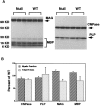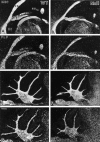Biochemical and morphometric analyses show that myelination in the insulin-like growth factor 1 null brain is proportionate to its neuronal composition
- PMID: 9671658
- PMCID: PMC6793060
- DOI: 10.1523/JNEUROSCI.18-15-05673.1998
Biochemical and morphometric analyses show that myelination in the insulin-like growth factor 1 null brain is proportionate to its neuronal composition
Abstract
To elucidate the role of insulin-like growth factor 1 (IGF1) in the normal development of brain myelination, we used behavioral, biochemical, and histological analyses to compare the myelination of brains from Igf1(-/-) and wild-type (WT) littermate mice. The studies were conducted at postnatal day 40, at which time the Igf1(-/-) mice weighed approximately 66% less than wild-type mice. However, the Igf1(-/-) brain weight was only reduced by approximately 34%. Formal neurological testing showed no sign of central or peripheral myelinopathy in Igf1(-/-) mice. Myelin composition was not significantly different, and myelin concentration, normalized to brain weight or protein, was equal in Igf1(-/-) and WT mice. Likewise, concentrations of myelin-specific proteins (MBP, myelin proteolipid protein, MAG, and 2',3'-cyclic nucleotide,3'-phosphodiesterase) were not significantly different in Igf1(-/-) and WT mice. The myelin-associated lipids galactocerebroside and sulfatide were modestly reduced in Igf1(-/-) brains. Regional oligodendrocyte populations and myelin staining patterns were comparable in Igf1(-/-) and WT brains, with the notable exception of the olfactory system. The Igf1(-/-) olfactory bulb was profoundly reduced in size and was depleted of mitral neurons and oligodendrocytes, and its efferent tracts were depleted of myelin. In summary, this study shows that myelination of the Igf1(-/-) brain is proportionate to its neuronal composition. Where projection neurons are preserved despite the deletion of IGF1, as in the cerebellar system, oligodendrocytes and myelination are indistinguishable from wild type. Where projection neurons are depleted, as in the olfactory bulb, oligodendrocytes are also depleted, and myelination is reduced in proportion to the reduced projection neuron mass. These data make a strong case for the primacy of axonal factors, not including IGF1, in determining oligodendrocyte survival and myelination.
Figures






References
-
- Andersson IK, Edwall D, Norstedt G, Rozell B, Skottner A, Hansson H-A. Differing expression of insulin-like growth factor I in the developing rat cerebellum. Acta Physiol Scand. 1988;132:167–173. - PubMed
-
- Ayer-Le Lievre C, Stahlbom PA, Sara VR. Expression of IGF-I and -II mRNA in the brain and craniofacial region of the rat fetus. Development. 1991;111:105–115. - PubMed
-
- Barres BA, Hart IK, Coles HSR, Burne JF, Voyvodic JT, Richardson WD, Raff MC. Cell death and control of cell survival in the oligodendrocyte lineage. Cell. 1992;70:31–46. - PubMed
-
- Barres BA, Jacobson MD, Schmid R, Sendtner M, Raff MC. Does oligodendrocyte survival depend on axons? Curr Biol. 1993;3:489–497. - PubMed
-
- Barres BA, Raff MC. Proliferation of oligodendrocyte precursor cells depends on electrical activity in axons. Nature. 1993;361:258–260. - PubMed
MeSH terms
Substances
LinkOut - more resources
Full Text Sources
Molecular Biology Databases
Research Materials
Miscellaneous
